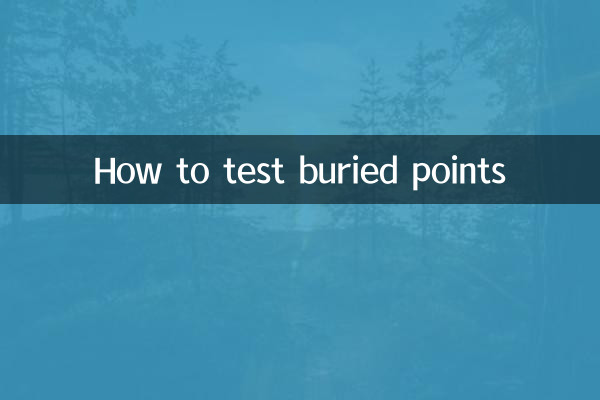How to test buried points
In today's data-driven era, point testing has become a key link to ensure data accuracy and reliability. Buried points refer to code snippets inserted in the front-end or back-end code to collect user behavior data. This article will introduce in detail the methods, tools and common problems of buried point testing, and provide structured data for reference.
1. The importance of buried point testing

The main purpose of buried point testing is to ensure the accuracy and completeness of data collection. If the hidden data is wrong, it may lead to biased data analysis results, which will affect business decisions. The following are the core goals of embedded testing:
1. Verify whether the hidden code is triggered correctly
2. Ensure the integrity and accuracy of data fields
3. Check the timeliness and stability of data reporting
4. Avoid repeated reporting or omissions
2. Method of buried point testing
Buried point testing is usually divided into the following steps:
| testing phase | Test content | Common tools |
|---|---|---|
| code review | Check the location and logic of buried code | Git, IDE |
| local test | Verify buried point trigger in development environment | Chrome DevTools, Fiddler |
| Grayscale test | Validate data collection among a small range of users | Firebase, Shence Data |
| Full test | Monitor data quality across all users | Kafka, Hadoop |
3. Common buried point testing tools
The following are the current mainstream buried point testing tools and their characteristics:
| Tool name | Applicable platforms | Main functions |
|---|---|---|
| Charles | All platforms | Network request packet capture and data modification |
| Fiddler | Windows | HTTP/HTTPS request monitoring |
| Chrome DevTools | Web | Front-end debugging, network monitoring |
| Wireshark | All platforms | Underlying network packet analysis |
4. Key indicators of buried point testing
When conducting hidden point testing, you need to pay attention to the following key indicators:
| Indicator name | Calculation formula | Compliance standards |
|---|---|---|
| Trigger rate | Actual number of triggers/expected number of triggers | ≥99% |
| data delay | Data reporting time - event occurrence time | ≤5 minutes |
| Field missing rate | Number of missing fields/Total number of fields | ≤0.1% |
5. Common problems and solutions for buried point testing
1.Buried point is not triggered: Check whether the code deployment is successful and whether the event triggering conditions are correct
2.Data field error: Verify field mapping relationships and check data conversion logic
3.Repeated reporting: Add deduplication mechanism and check event trigger frequency
4.data delay: Optimize reporting strategy and increase network monitoring
6. Best Practices for Buried Testing
1. Establish a complete buried point document to record the purpose and field definition of each buried point.
2. Conduct hidden testing during the development stage instead of waiting until before launch
3. Use automated testing tools to continuously monitor data quality
4. Conduct regular data quality audits and repair discovered problems.
Through the above methods and tools, buried point testing can be effectively carried out to ensure the accuracy and reliability of data collection. Good buried testing practices will provide a solid foundation for the company's data analysis and business decisions.

check the details

check the details